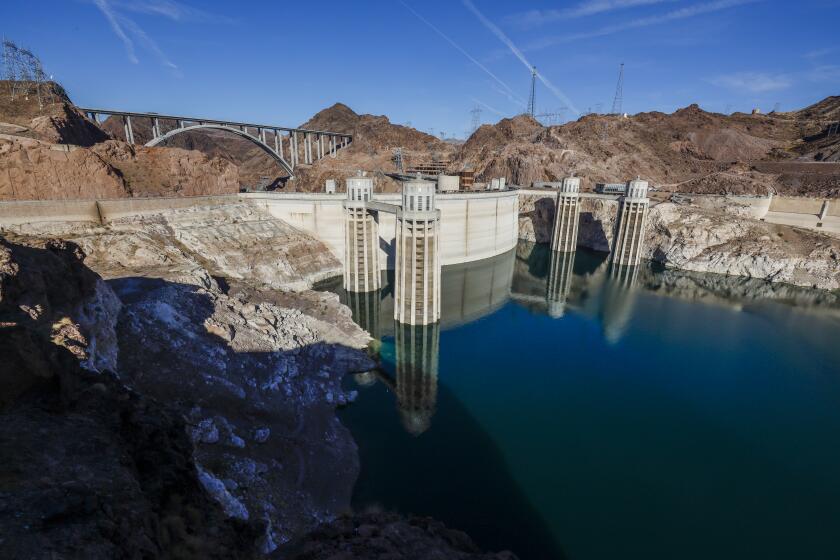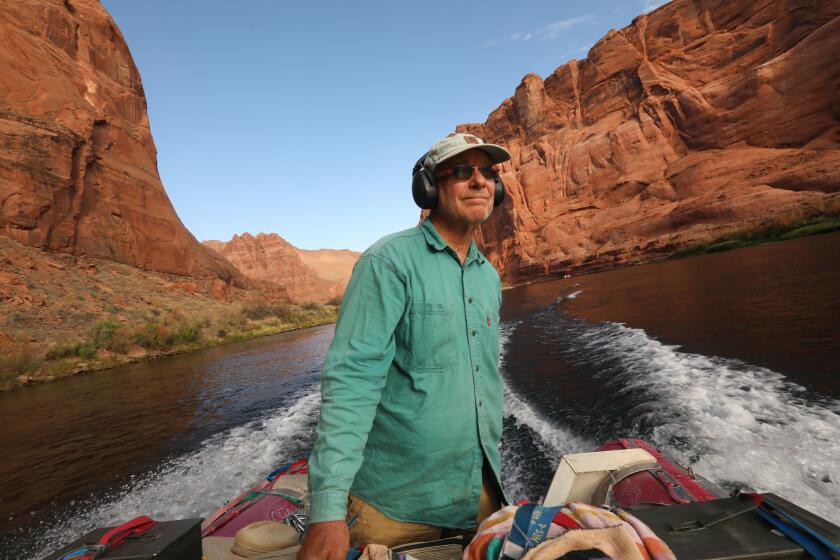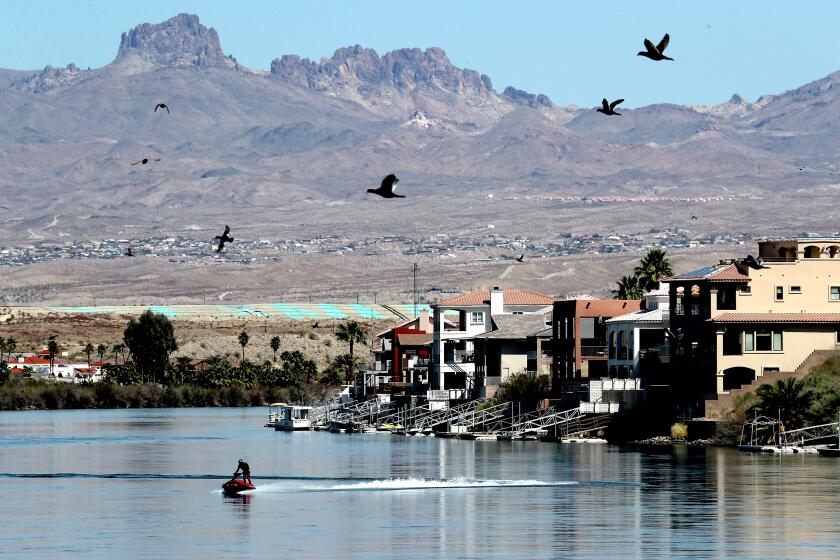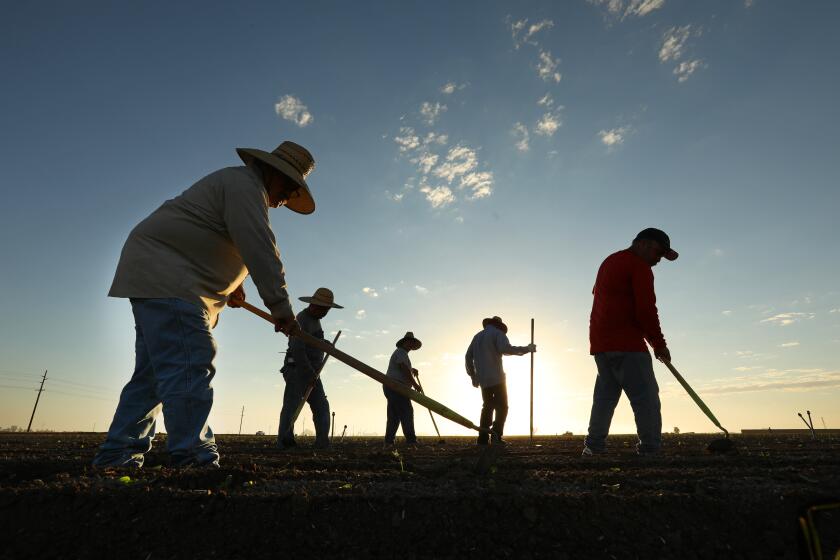As the Colorado River shrinks, federal officials consider overhauling Glen Canyon Dam
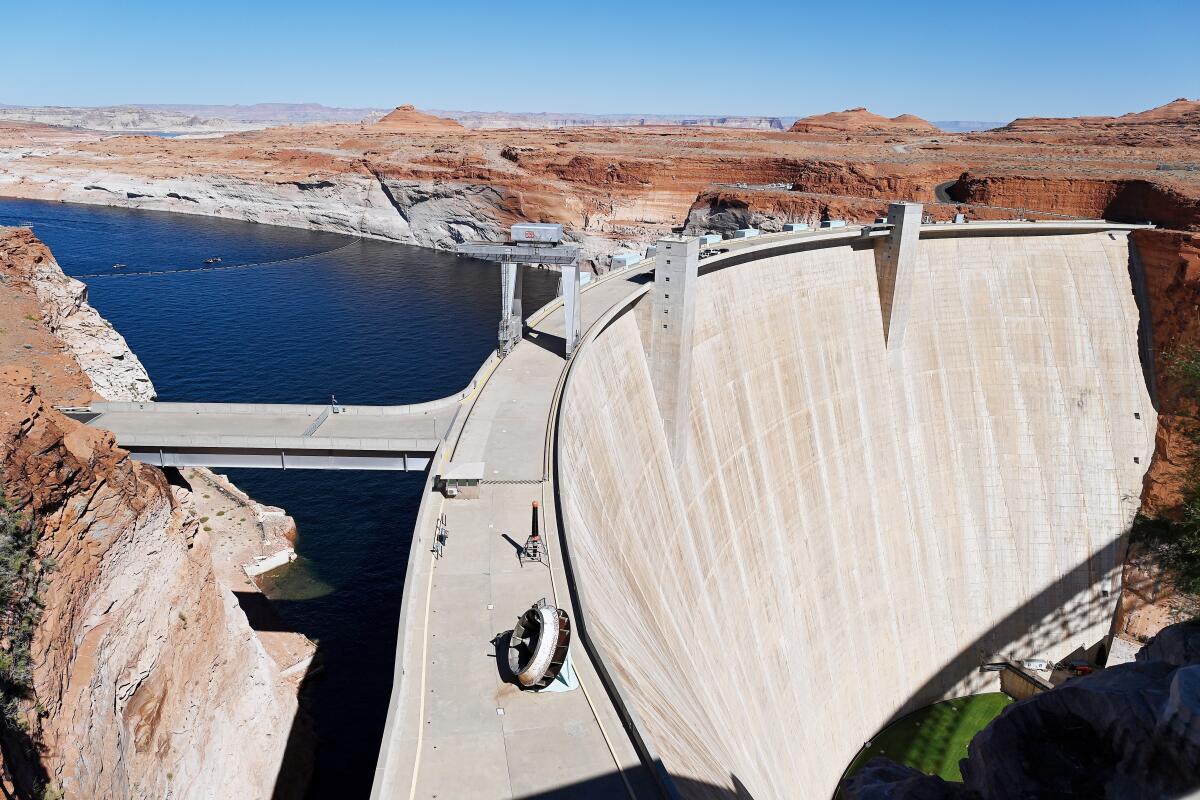
- Share via
The desiccation of the Colorado River has left Lake Powell, the country’s second-largest reservoir, at just 23% of capacity, its lowest level since it was filled in the 1960s.
With the reservoir now just 32 feet away from “minimum power pool” — the point at which Glen Canyon Dam would no longer generate power for six states — federal officials are studying the possibility of overhauling the dam so that it can continue to generate electricity and release water at critically low levels.
A preliminary analysis of potential modifications to the dam emerged during a virtual meeting held by the federal Bureau of Reclamation, which is also reviewing options for averting a collapse of the water supply along the river. These new discussions about retooling the dam reflect growing concerns among federal officials about how climate change is contributing to the Colorado River’s reduced flows, and how declining reservoirs could force major changes in dam management for years to come.
Among the immediate concerns is the threat of the reservoir dropping below the dam’s power-generating threshold. If that were to occur, water would only flow through four 8-foot-wide bypass tubes, called the outlet works, which would create a chokepoint with reduced water-releasing capacity.
“There is now an acknowledgment, unlike any other time ever before, that the dam is not going to be suited to 21st century hydrology,” said Kyle Roerink, executive director of the environmental group Great Basin Water Network, who listened to the meeting. “They’re not sugarcoating that things have to change there, and they have to change pretty quickly.”
Those who participated in the Feb. 7 meeting included dozens of water mangers, representatives of electric utilities, state officials and others. They discussed proposals such as penetrating through the dam’s concrete to make new lower-level intakes, installing a new or reconfigured power plant, and tunneling a shaft around either side of the dam to a power plant, among other options.
How to divide Colorado River cuts: A breakdown of how California’s proposed water reductions compare with an offer submitted by six other states
The Interior Department declined a request for an interview, but spokesperson Tyler Cherry said in email that the briefing was part of broader conversations with state officials, tribal leaders, water managers and others “to inform our work to improve and protect the short-term sustainability of the Colorado River System and the resilience of the American West to a changing climate.”
Roerink and two other people who listened to the webinar told The Times that cost estimates for several alternatives ranged from $500 million to $3 billion. The agency will need congressional approval and will have to conduct an environmental review to analyze options.
The Bureau of Reclamation’s presentation, given by regional power manager Nick Williams, included some additional alternatives that wouldn’t require major structural modifications of the dam. Those options included adjusting operations to maximize power generation at low reservoir levels, studying ways of using the existing intakes at lower water levels, and making up for the loss of hydroelectric power by investing in solar or wind energy.
Drought and global warming have transformed the Colorado River, making some sections unrecognizable to those who have spent decades on the river.
Glen Canyon Dam stands 710 feet tall, anchored to the canyon’s reddish sandstone walls in northern Arizona, about 320 miles upstream from Lake Mead, the nation’s largest reservoir. The dam has been controversial since its inception, with environmental activists and others arguing the reservoir was unnecessary and destroyed the canyon’s pristine ecosystem.
Lake Powell and Lake Mead have declined over the last 23 years during the most severe drought in centuries. Federal officials have sought to boost Powell’s levels in recent months by reducing the amount of water they release downstream until the spring runoff arrives. They’ve said they may need to further cut water releases.
A central concern is that if the water drops below minimum power pool — 3,490 feet above sea level under the current operating rules — the main intakes would need to be shut down and water would instead flow through the dam’s lower bypass tubes. Because of those tubes’ reduced capacity, that could lead to less water passing downstream, shrinking the river’s flow in the Grand Canyon and accelerating the decline of Lake Mead toward “dead pool” — the point at which water would no longer pass through Hoover Dam to Arizona, California and Mexico.
Federal officials prepared the initial studies of alternatives for Glen Canyon Dam using $2 million that the Bureau of Reclamation secured as part of $200 million for drought response efforts.
According to a slide presentation shown at the meeting, officials see potential hazards in some of the six alternatives. Piercing the dam’s concrete to create new low-level or mid-level intakes, for example, would entail “increased risk from penetration through dam,” the presentation says.
They also describe risks due to possible “vortex formation,” or the creation of whirlpools above horizontal intakes as the water level declines. Their formation could cause damage if air is pulled into the system. The presentation says one alternative would involve lowering the minimum power pool limit and possibly installing structures on the intakes to suppress whirlpools, but it said this still would not allow for the water level to go much lower.
Colorado River in Crisis is a series of stories, videos and podcasts in which Los Angeles Times journalists travel throughout the river’s watershed, from the headwaters in the Rocky Mountains to the river’s dry delta in Mexico.
One of the possible fixes includes installing a new power plant that would generate electricity with water flowing from the bypass tubes, or taking a similar approach using existing infrastructure. Another would involve excavating a tunnel to the left or right side of the dam, and installing a power plant underground or in the riverbed.
Other options include changing operations at both Glen Canyon and Hoover dams “to maximize power generation under low flow conditions using existing infrastructure.”
“Any of the options are going to be very expensive and they’re going to be very time-consuming,” said Leslie James, executive director of the Colorado River Energy Distributors Assn., who participated in the meeting.
James praised the Bureau of Reclamation for “starting the processes to look at structural options like this.”
“I see what they’re doing here as getting an early start and at least evaluating everything that they can to look and see what may be feasible,” James said. She said she hopes Congress will provide the necessary funding to ensure continued electricity flowing from Glen Canyon Dam, given “how important hydropower is to entire communities.”
Her association represents nonprofit electric utilities that buy power produced by Glen Canyon Dam and other dams that are part of the Colorado River Storage Project. The association includes members in Arizona, Colorado, Nevada, Utah, New Mexico and Wyoming. The utilities supply power in cities, rural areas, irrigation districts and tribal communities.
Power from the dam has long been a vital energy source, though its output has decreased dramatically in recent years as Lake Powell has declined. During the 2022 fiscal year, Glen Canyon Dam generated 2,591 gigawatt-hours of electricity, enough to power more than 240,000 average homes for a year.
James said electric utilities across the region have had to make up for the reduced hydropower by turning to other costlier sources.
“It’s a real challenging time,” James said. “And it is the people in these communities that are ultimately being impacted with higher electricity bills.”
Debate over Colorado River cutbacks centers on whether water lost to evaporation should be counted. Changing the formula would hit California hard.
Lake Powell’s level is projected to rise this spring with runoff from the above-average snowpack in the Rocky Mountains. But that boost in water levels is expected to have a limited effect on the deep water deficit that has accumulated over more than two decades.
And in the long term, scientific research indicates warming and drying will continue to take a major toll on the river.
Scientists have found that roughly half the decline in the river’s flow since 2000 has been caused by higher temperatures, that climate change is driving the aridification of the Southwest, and that for each additional 1 degree Celsius (1.8 degrees Fahrenheit) of warming, the river’s average flow will probably decrease about 9%.
Environmental activists have for years urged the federal government to consider draining Lake Powell, decommissioning the dam and storing the water downstream in Lake Mead.
Activists who listened to the Bureau of Reclamation’s presentation said they welcome the agency’s examination of the issues at Glen Canyon Dam but would prefer to see a broader analysis that evaluates other options, including draining the reservoir.
In a report last year, Roerink’s Great Basin Water Network and two other groups warned that the “antiquated plumbing system inside Glen Canyon Dam represents a liability to Colorado River Basin water users who may quickly find themselves in legal jeopardy and water supply shortfalls.”
“The bureau is admitting that the dam is a liability,” Roerink said. “From my perspective, that’s a good first step.”
Beyond the current focus on trying to prop up hydropower generation, Roerink said, “I think we need an option that is just a bypass option without a power plant at the end of it.”
Roerink said he expects there will be a lot of debate about issues such as evaporation from the reservoir and the high costs of modifications to the dam.
“Is it all worth it? Are the taxpayer dollars going to be worth it for those electrons?” Roerink said. “How long will it be until this just proves itself to be a futile exercise?”
As the federal government pushes states to reduce usage of dwindling Colorado River water, Imperial Valley farmers fear a “worst-case” scenario.
John Weisheit, an activist who has advocated for removing the dam, said he was delighted to hear federal officials openly discussing these options for the first time.
“I’m glad we’re having this conversation. It’s long overdue,” said Weisheit, who is co-founder of the group Living Rivers.
Weisheit said he also thinks the agency’s alternatives aren’t broad enough, and leave unanswered questions about the dam’s life span.
“I think it’s imperative that we know exactly what the life span of this dam is,” Weisheit said. “There is so much more that needs to be discussed.”
Weisheit said one major concern should be the accumulation of sediments in the bottom of the reservoir, which, according to a recent federal survey, has lost nearly 6.8% of its water-storing capacity.
Another issue with the agency’s current alternatives, he said, is that they wouldn’t solve problems of intakes or bypass tubes sucking in air at low water levels, “just like everybody’s bathtub does,” potentially causing cavitation that would pit and tear into metal, damaging the infrastructure.
Weisheit said he also was concerned about potential threats to endangered fish in the Grand Canyon.
Overall, the modifications to the dam that the federal government is considering would be “too much investment for very little return,” Weisheit said. “And it’s going to take a long, long time.”
Weisheit said he favors the option of investing in solar and wind energy. Instead of spending up to $3 billion trying to squeeze a shrinking amount of power from the dam, he said, “you can build a lot of solar cells and turbines,” including nearby on the Navajo Nation, which needs electricity.
Weisheit said he thinks the situation shows Glen Canyon Dam isn’t needed.
“Take the dam out,” he said, “because it’s not the right dam for climate change.”
